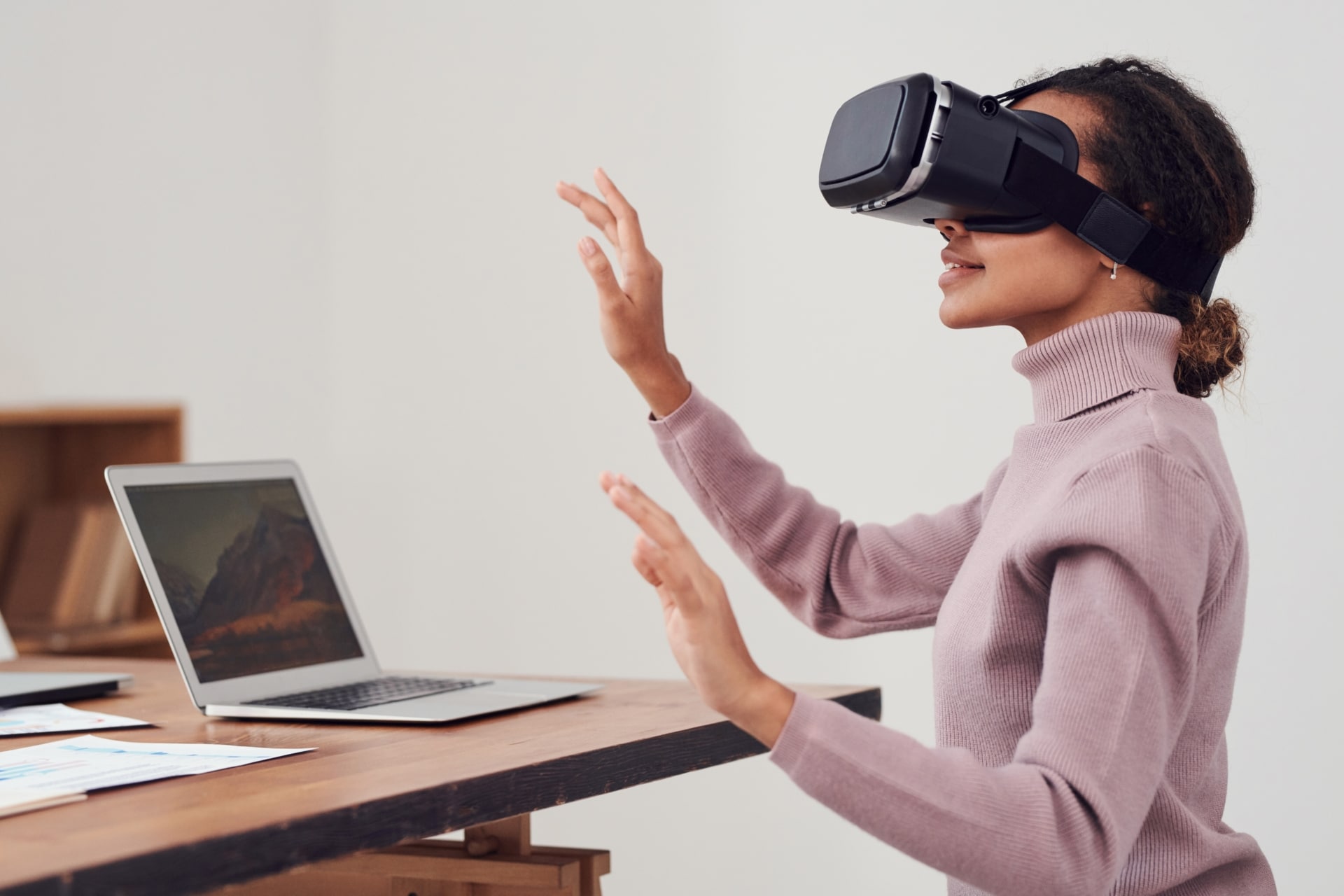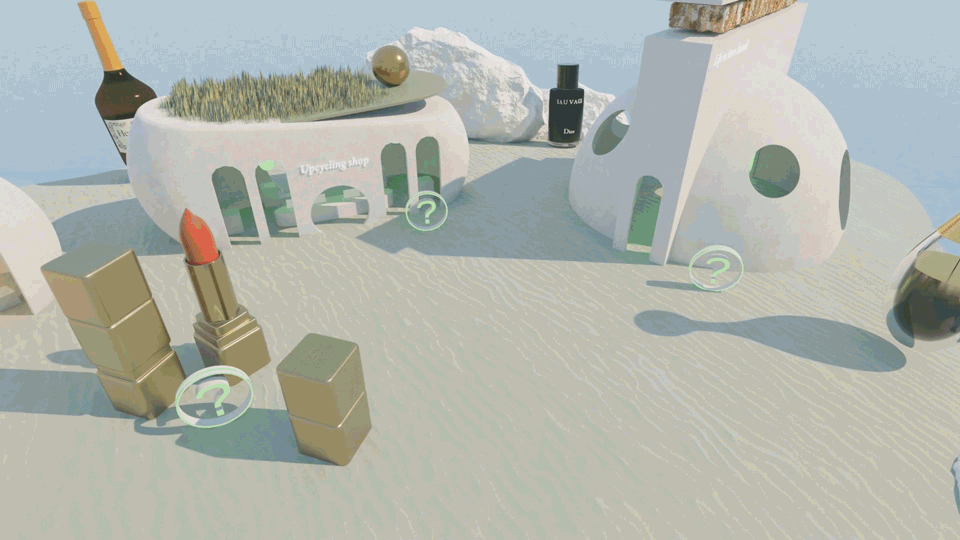
The Benefits of Using Immersive Technology

Immersive technology is quickly becoming a popular and powerful tool for people in many industries. It provides an unprecedented level of interaction, engagement, and immersion that isn’t available with traditional methods.
Whether you’re using it to power up your customer experience or create a digital training platform for employees, the benefits of immersive reality are genuinely innovative. We’ll take a closer look at what immersive technology offers businesses and how it can create more effective outcomes.
Is technology causing you to make changes within your management? See how Emeraude Escape can help make these changes less of a headache.
Related: How we are transforming companies through gamification
What is Immersive Technology?
Immersive technology is cutting-edge digital communication catering to the visual and auditory senses. This technology communicates with users through visual and auditory information, prompting users to wear headsets allowing them to explore an artificial world.
With Virtual Reality (VR) generating a simulated environment and Augmented Reality (AR) opening doors to the mixing of digital assets with physical space and objects, immersive technology creates a unique experience for its users. From gaming consoles to VR applications, businesses have found many ways of utilizing this modern invention to capture the attention of their customers.
Types of Immersive Tech
The field of immersive technology is continuing to grow as more pioneering tools are added to the list each year that provide innovative ways for people to interact with their environment.
There are different types of Immersive tech that businesses can use for customers to interact with their environment. This immersive tech includes 360, VR, AR, MR, and XR. Below we’ll explore these technologies to help you understand them better.
- 360 stands for 360-degree video. It is created by stitching panoramic images or photos to completely encompass the viewer’s visual space and replicate a real-life environment.
- VR offers an entirely computer-generated simulation of the physical world that gives users total control over the environment around them.
- AR combines digital enhancements with the real world, where viewers can interact with elements using gestures and voice commands.
- Mixed Reality (MR) refers to a hybrid reality where digital objects interact seamlessly with their physical counterparts or virtual overlays of our tangible world.
- Extended Reality (XR) is an umbrella term encompassing virtual, augmented, and mixed realities. It also uses simulation technologies such as AI and bots.
We are already experiencing life differently thanks to immersive technologies, from virtual medical procedures and interior design shopping trips to digital access to tourism destinations. These advancements prove this technology will only grow in importance in the years to come.
What is an Immersive Experience?

An immersive experience is an engaging, interactive experience that envelops a person entirely in the activity. It can involve interacting with others or being taken away from the everyday hustle and bustle to explore an exciting environment.
From cycling through virtual worlds to exploring a museum gallery in 3D, these experiences keep us constantly engaged and show us something new every time. For example, attending a concert in virtual reality will give us a unique feeling of presence that we would otherwise not have.
Immersive reality also plays an increasingly important role in education and entertainment. The technology shows how different scenarios may play out, allowing people to make decisions without face-to-face contact with others. Ultimately, immersive reality provides thrilling adventures that help teach new skills while entertaining us.
Related: Immersive experience, a lever to attract and retain talent
Benefits of Utilizing Immersive Technologies in Physical Environments
The integration of immersive technologies such as AR/VR, 360-degree video, MR, and XR in physical environments is revolutionizing how brands interact with customers.
Using these technologies in physical environments with multimedia components can significantly enhance the customer experience and provide brands with a powerful tool for marketing and engagement.
Enhancing Customer Experience and Engagement
Immersive technology creates a highly engaging experience for customers, allowing them to interact with the brand in an interactive and memorable way.
For example, a cosmetic brand wants to launch a new line of skin care products and create a memorable and engaging customer experience. So they create an AR-powered in-store event where customers can try on the products virtually using their smartphones.
Customers enter the store and download the brand’s AR app. Once they have the app, they can point their smartphone at specific posters or product displays to activate the AR experience. The AR experience allows customers to try the skincare products virtually, seeing how they look and feel before making a purchase.
The brand effectively leveraged AR to increase customer engagement and awareness, increasing sales and customer loyalty.
Increasing a Customer’s Product Knowledge

Brands can utilize immersive technology to showcase their products dynamically and interactively, allowing customers to fully comprehend the product’s features, benefits, and unique qualities.
A furniture retailer wants to showcase a new line of ergonomic office chairs. In addition, they want to create an interactive and engaging experience for customers to help them understand the features and benefits of the chairs.
They create a VR experience that customers can try in-store. Customers put on a VR headset and are transported to a virtual office where they can try the chairs in a simulated work environment. The VR experience allows customers to adjust the chair’s height, tilt, and lumbar support and see how the chair feels in a realistic setting.
Customers can see how the chairs adjust to their bodies, how they feel in a real-world environment, and how they can improve their posture and comfort while working.
Expanding Sales and Marketing Opportunities
Immersive technology presents brands with many marketing prospects, including in-store events, brand activations, virtual product demonstrations, and interactive product tours.
A luxury car manufacturer wants to launch a new sports car model. In addition, they want to create a memorable and engaging customer experience to build brand awareness and drive sales.
The manufacturer creates a mixed reality (MR) experience that customers can try at select car dealerships. Customers put on an MR headset and are transported to a virtual race track to experience the thrill of driving the new sports car. The MR experience provides a realistic and immersive experience, with the virtual vehicle appearing in the same physical space as the customer.
This MR experience not only provides customers with an exciting and memorable experience but also provides the manufacturer with a new marketing opportunity.
Additionally, the MR experience can be used at trade shows, auto shows, and other events to reach new audiences and generate interest in the new sports car model.
Improving Accessibility
Using immersive technology can also enhance accessibility in physical environments, enabling individuals with disabilities to participate in experiences that may have previously been inaccessible.
A museum aimed to create an interactive and immersive experience for visitors while ensuring the experience was accessible for individuals with disabilities. They decided to make an XR experience that visitors could try using their smartphones.
The XR experience allowed visitors to explore the museum and its exhibits in a virtual environment. Visitors could point their smartphones at specific exhibits to activate the XR experience, which provided an interactive and immersive experience.
The XR experience was also designed to be accessible for individuals with disabilities, with options for audio descriptions and text-to-speech for visitors who were blind or had low vision.
This XR experience provided visitors with an interactive and immersive experience. In addition, it ensured that the experience was accessible for individuals with disabilities. As a result, the museum effectively used XR to create a more inclusive and accessible experience for visitors, providing a positive and memorable experience for all visitors.
Elevating Customer/Employee Safety
Immersive technology can increase safety in physical environments by allowing customers to experience a product or environment without physical interaction.
A construction company wanted to showcase a new building project to potential clients. Still, they also wanted to ensure the safety of the clients and workers on the construction site. So they decided to create a 360-degree video experience that clients could view from the comfort of their own office.
The 360-degree video experience allowed clients to explore the construction site and see the progress of the building project from all angles. The video was shot from a drone, providing a safe and secure view of the construction site without the need for clients to visit the site physically.
The construction company effectively used 360-degree video to increase safety and provide clients with a valuable and informative experience, contributing to the building project’s success.
Emeraude Escape Solution: Raise awareness about occupational hazards through a digital game
Benefits of Immersive Technology
Now that you know what immersive technology is, you may wonder what’s the benefit of using it. Below you’ll find six benefits of immersive reality.
Improve Customer Experience and Engagement
Immersive technology provides a significant impact on customer experience and engagement. Companies can use this technology to create an immersive reality in which the customers directly engage.
Using VR headsets, haptic devices, and other technologies, companies can offer specialized experiences allowing customers to fully immerse themselves in the product or service they are purchasing. The result is greater dynamic user engagement, and increased customer satisfaction as barriers to acquiring products are reduced significantly.
Moreover, with this technology, businesses can further optimize and refine their products and services based on customer feedback, helping them better understand their customers’ needs, preferences, and behaviors.
Increase Efficiency
The technology has the potential to drastically reduce the training time required for specific tasks while allowing workers to engage more deeply with their work. With the increasing number of productivity apps that make use of this technology, businesses have a greater ability to streamline processes, automate tedious tasks and use analytics for better decision-making.
Attract Top Talent
Instead of relying solely on traditional recruiting methods, companies can tap into the potential of immersive technologies to find the most talented individual for the job. In particular, immersive technologies allow potential employees to experience what it would be like to do a job or go on a business trip without leaving their current location. It helps recruiters assess candidates more accurately but also helps them connect with job seekers in ways that weren’t previously possible.
Boost Onboarding and Employee Training
Virtual reality provides a safe and interactive environment where companies can simulate real-world scenarios that trainees would experience in the workplace. It can come close to providing learners with a realistic demonstration of their job duties so that they can understand their role within the organization better.
Also, employee engagement can improve during classroom-style learning sessions and help organizational policies become second nature more quickly. Furthermore, augmented reality in employee training allows trainees to interact with data and images, eliminating interruptions and disruptions during the learning process.
Accelerate Product Design and Development
Immersive technology enables businesses to visualize their designs in 3D, allowing them to make changes quickly and precisely. By allowing products to be tested virtually before they are actually made, it eliminates any potential issues upfront – saving businesses time, money, and resources.
Enhance Collaboration
Immersive technology provides an interactive environment that brings people together from anywhere in the world and allows them to work together through shared digital experiences. For example, immersive technology can outfit a remote expert with a headset to offer real-time point-by-point instruction or advice to colleagues. In addition, team members can hold virtual discussions where all participants see the same content simultaneously for deeper collaboration.
Future Immersive Technologies

As many industries use immersive reality for their business, it may make you wonder if incorporating it into your company is worth the risk. In the future, immersive technology is expected to be used for everyday purposes.
For example, As early as 2025, immersive reality is predicted to be incorporated more into our mobile devices. In addition, there’s a prediction for AR reality, such as metaverse, to break down barriers between the digital and physical worlds.
Lastly, AR is making improvements in how businesses do advertisements. Marketing through AR allows companies to provide information to customers in a more compelling way and improves their experience without them having to spend more money. As a result, corporating immersive technology into your business may be worth the risk as it advances.
Metaverse is making waves in our world, and it’s only here to stay. We can create the perfect metaverse platform for your company with custom avatars, 2D or 3D environments, integration, and more! Come discover more about how we develop this gamification technique.
You Should Implement Immersive Tech to Stay Ahead of the Competition
Consumers are always looking for ways to be further engaged with the brands they love. As a business owner, staying ahead of the competition is vital by incorporating immersive technology into your advertising and marketing campaigns. By using immersive reality, you can provide an interactive experience that will leave consumers wanting more.
Discover


Book A Demo
Get a personalized demonstration by one of our game design experts.


